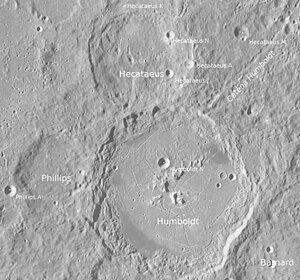Hecataeus (Mondkrater)
| Hecataeus | ||
|---|---|---|
 | ||
| Hecataeus (oben Mitte) und Umgebung (LROC-WAC) | ||
| Position | 22,12° S, 79,54° O | |
| Durchmesser | 143 km | |
| Tiefe | 4780 m[1] | |
| Kartenblatt | 99 (PDF) | |
| Benannt nach | Hekataios von Milet | |
| Benannt seit | 1935 | |
| Sofern nicht anders angegeben, stammen die Angaben aus dem Eintrag in der IAU/USGS-Datenbank | ||

Hecataeus ist ein Einschlagkrater am östlichen Rand der Mondvorderseite, südöstlich des Mare Fecunditatis, nordwestlich des großen Kraters Humboldt, an dessen Rand er unmittelbar anschließt.
Der Kraterrand ist stark erodiert, das Innere ist uneben und weist Spuren der Überlagerung des Randes des Nebenkraters Hecataeus K auf.
| Buchstabe | Position | Durchmesser | Link |
|---|---|---|---|
| A | 21,87° S, 81,79° O | 11 km | [1] |
| B | 19,38° S, 75,61° O | 68 km | [2] |
| C | 18,96° S, 73,03° O | 20 km | [3] |
| E | 18,52° S, 72,61° O | 14 km | [4] |
| J | 22,51° S, 80,88° O | 12 km | [5] |
| K | 19,66° S, 79,59° O | 94 km | [6] |
| L | 19,11° S, 78,85° O | 24 km | [7] |
| M | 20,76° S, 84,2° O | 20 km | [8] |
| N | 20,9° S, 80,93° O | 11 km | [9] |
Der Krater wurde 1935 von der IAU nach dem griechischen Geographen und Philosophen Hekataios von Milet offiziell benannt.
Weblinks
Einzelnachweise
- ↑ Ernest H. Cherrington: Exploring the Moon Through Binoculars and Small Telescopes. Dover Publications, New York NY 1969 (Auch: ebenda 1984, ISBN 0-486-24491-1).
Auf dieser Seite verwendete Medien
NASA lunar chart of equatorial region (latitudes 45S to 45N) 1 : 10.000.000 (LPC-1).
Craters Humboldt, Hecataeus and Philipps (detail of LRO - WAC global moon mosaic; Mercator projection)
This oblique view of the Moon was taken during the Apollo 15 mission. At the center is the Hecataeus crater, with Humboldt to the lower left and the smaller Phillips crater near the limb at bottom center. Note the dark patches on the interior floor of Humboldt. A portion of the Apollo spacecraft is visible along the center right edge of the image. This image was taken during the Apollo 15 mapping metric on revolution 71 from an altitude of 115 km. The selenographic coordinates of the image are 21.5° S, 79.5° E. The picture was reduced in size to 25%, cropped slightly, then rotated 90° counter-clockwise so that north is to the top.



